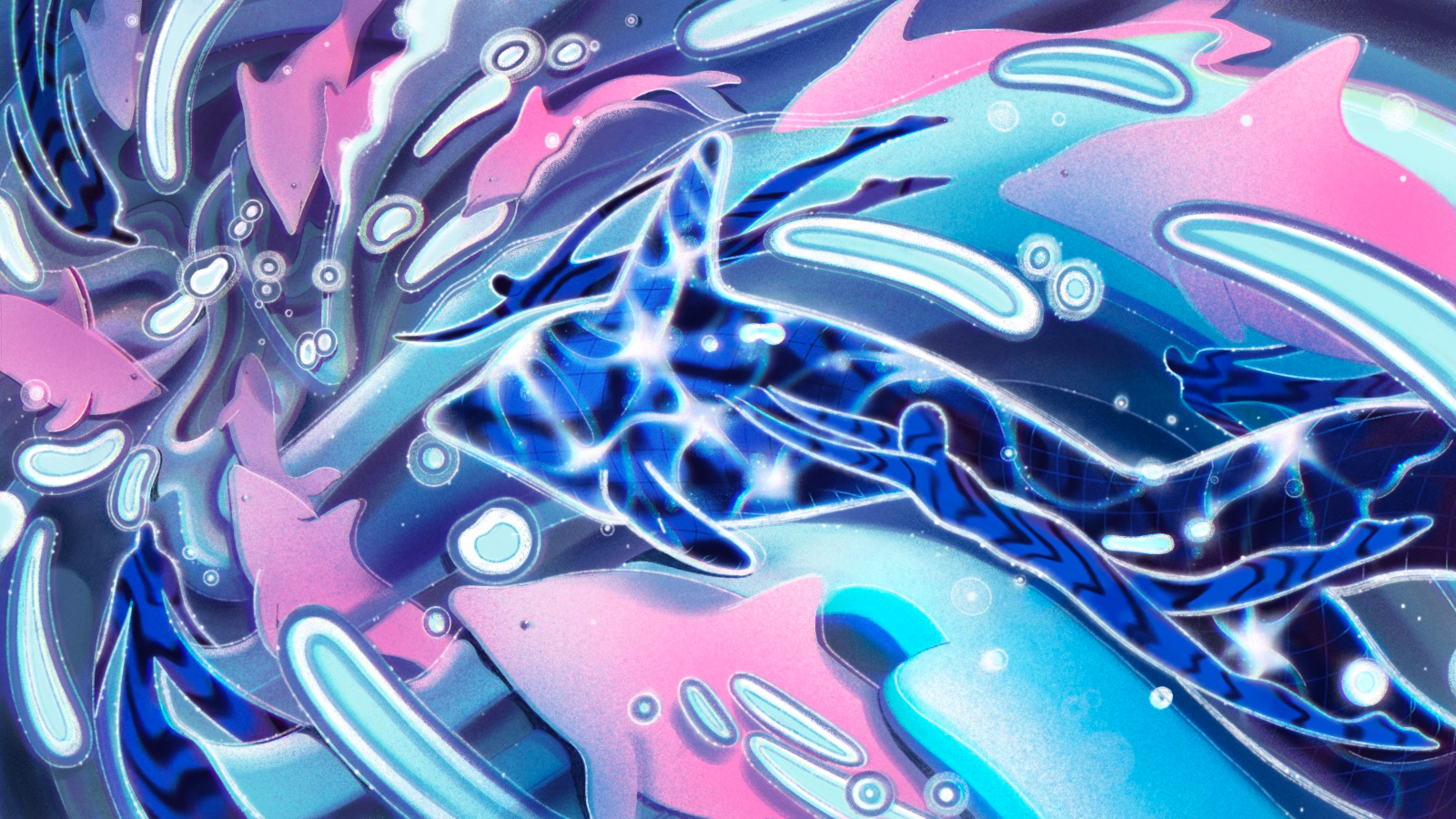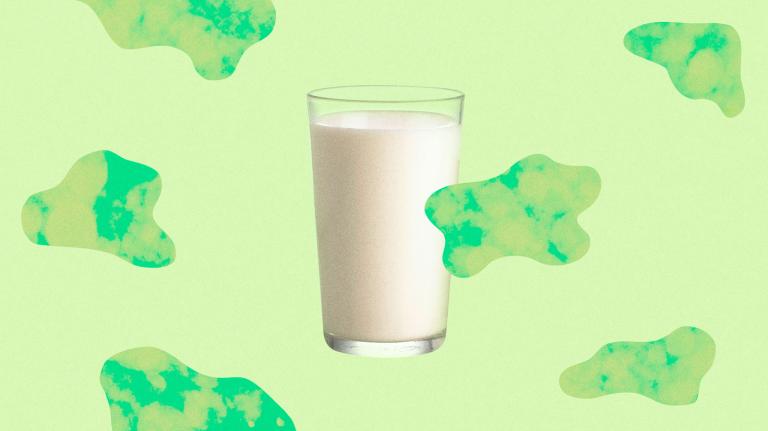This story is part of Fix’s Climate-Fiction Issue, which explores how fiction can create a better reality. Check out the full issue here, including the short stories in Fix’s first-ever climate-fiction contest, Imagine 2200.
Plastic. It’s everywhere — swirling in a huge gyre in the Pacific Ocean, choking birds, stabbing turtles in the nose, and clogging drains in our cities. The World Economic Forum says there could be more of this ubiquitous material than fish in the ocean by 2050. And plastic, by design, essentially lasts forever, breaking down into ever-smaller particles that make their way into just about everything, including our drinking water.
It also doesn’t recycle well. The soda bottle you just tossed into the blue bin probably won’t become another soda bottle. Plastic typically gets “downcycled” into composite products like faux wood or carpeting. Less than 10 percent gets recycled, in part because virgin plastics are cheaper than the post-consumer stuff. The vast majority ends up in landfills — or worse, it makes its way out of the waste stream to clutter the world.
Ridding our environment of plastic waste won’t be easy, even if Meg Thee Stallion organizes hundreds more beach cleanups. But some scientists are taking a cue from nature to solve this problem. They’re looking at plastic-eating critters.
You read that right. Biologists have discovered more than 50 species of “plastivores” — mainly bacteria and fungi, and one particularly efficient grub known as the wax worm — that can consume and metabolize polyethylene. The goal in studying them is to devise scalable processes that could change how we deal with discarded plastic.
This research inspired a fictional invention that plays a key role in Tidings, the third-place winner of Imagine 2200, Fix’s climate-fiction contest. In the story’s opening scene, engineer Tsayaba Issoufou and her cousin Ouma test a tiny trash-eating robot. The machine, “modeled after a wax worm’s digestive tract,” walks on cilia-like feet that can easily scuttle over all types of terrain. Later scenes show the machines (named after Ouma) at work in various settings, realizing Tsayaba’s dream of “a whole swarm of the biomachines crawling through the sand, swimming through the ocean, breaking down tons upon tons of low-density polyethylene without a wisp of greenhouse gases escaping. It’s a thrilling vision.”
It is. And although a fleet of autonomous wormlike robots represents one possible, though perhaps improbable, future of plastivore research, biologists are making exciting progress developing real-world applications for wax worms and other plastic eaters.
A very hungry caterpillar
Federica Bertocchini discovered the wax worm’s penchant for plastic by accident. The critters are the larvae of the greater wax moth, and they feed on honeycombs — which, it turns out, have a chemical composition similar to plastic. In 2017, Bertocchini, a molecular biologist at the Spanish National Research Council and an amateur beekeeper, removed some of the caterpillars from her hives and tossed them into a plastic bag. Later, she was surprised to find holes in the bag and concluded that the wriggling pests had eaten through it.
Other labs have since confirmed that these ravenous caterpillars can survive on a diet of pure polyethylene, excreting a type of alcohol called glycol as they go. “You give a wax worm plastic, they’ll go to town on that plastic all day long,” says Bryan Cassone, an entomologist at Brandon University in Manitoba, Canada. But still, a tiny caterpillar can only eat so much plastic during a larval stage that lasts just two to four weeks. Using the worms as plastic digesters isn’t out of the question, but it would require quite a production.
“You give a wax worm plastic, they’ll go to town on that plastic all day long.”
— Entomologist Bryan Cassone
“If you want to really make a dent in the plastic waste, you’re going to have to have actual facilities that are just producing wax worms,” Cassone says. Like, a lot of wax worms. He believes that’s doable, especially if the caterpillars can be turned into something useful when their weeks of eating plastic are up — for example, becoming feed for fish, which love the fatty worms. There’s also the question of what to do with all the glycol they’d produce. Although it’s a form of alcohol, no one’s been able to pinpoint exactly what it is.
Another avenue of research involves looking within the organism to copy its genes and gut microbes to create biofermenters that could mimic the animal’s digestion process. These systems, although stationary, would resemble the idea behind the ouma from Tidings.
Still, this doesn’t solve the issue of recycling. Wax worms excrete alcohol, not new plastic. So even if the worms are able to guzzle it up, factories are going to keep burning fossil fuels to create plastic as long as consumers keep demanding it.
A bacterial solution
Although the wax worm and its gut flora are particularly efficient at eating plastic, another species of plastivore is being explored that could help solve the production part of the problem as well. Researchers at the National Renewable Energy Laboratory in Colorado are exploring how the common soil bacteria Pseudomonas putida can “upcycle” plastic. In a study published earlier this year, they demonstrated a process through which the bacteria, with the help of some chemistry, can turn polyethylene terephthalate (PET, the most common type of polyester) into a replacement for nylon (a type of silklike plastic with many applications beyond pantyhose).
The lab is part of the BOTTLE consortium (Bio-Optimized Technologies to keep Thermoplastics out of Landfills and the Environment), a multi-organization research partnership supported by the U.S. Department of Energy. The group is focused not only on solving the plastic issue of today, but also designing better, more readily recyclable plastics for the future.
Biologist Alli Werner, the lead author of the study, and her team used a chemical process to break down PET into its component parts, called monomers. Then they fed those building blocks to specially engineered P. putida, which, wonderfully, excreted a compound called β-ketoadipic acid that can be used to make a type of nylon that’s superior to what’s widely used today. For one, it can function at higher temperatures, so it could be used in things like automotive parts. “It’s also less permeable to water, which is actually a main drawback of current nylon,” Werner says.
“This is the idea behind plastics upcycling,” says Werner, “turning waste into higher-value materials so that reclaiming plastics can be profitable.” That could provide an incentive to adopt the process at a far larger scale — which is almost as important as making it work in the first place. Her team plans to perform a techno-economic analysis of their process to assess its viability for industrial use and identify how they could make it more cost-effective.
Tidings doesn’t cover the commercial side of the ouma’s rise or explore what happens to the plastic once the tiny robots chomp it up. But Werner has an idea. “In a perfect world, it could be like a caterpillar-spider hybrid, and it’s just excreting a strand of performance-advantaged nylon,” she says. “Chopped-up bottles and carpet go in its mouth, and then a strand of nylon that could be made into sweat-wicking shorts comes out the other end.”
That’s a thrilling vision indeed. But the more likely application, Werner and Cassone say, is a sort of plastic waste–processing plant. Instead of taking the process to the plastic, waste could be brought to facilities housing wax worms or P. putida and turned into fish food or nylon.
“That is a very different question from what do we do about all the plastic that is already in the ocean,” Werner says. For that, we might need Megan Thee Stallion — and the rest of us — to really hustle on those beach cleanups.
The greater goal of these processes would be to keep plastic from becoming ocean trash in the first place. “We have really high hopes that if, one day, we can deploy this type of technology at scale, far less plastic will ever enter the environment,” Werner says.
She recalls, as a child in Michigan, picking up every aluminum can she saw — not necessarily because it was the green thing to do, but because Werner knew she could get a 10-cent refund for it. That relatively small incentive made it worth the effort to grab the cans. On a much larger scale, if we can make plastic waste valuable, and employ industrial processes for upcycling it, we may see a world where we would no longer need something like the free-roaming robotic ouma.
Explore more from Fix’s Climate Fiction Issue:
- The power of climate fiction to bring about real-world justice
- A glossary of need-to-know climate-fiction terms and genres
- Read the 12 winning stories of Fix’s climate-fiction contest




